
Welcome to my Work PageA non-serious look at things I did at workNow that I have retired, it is easier to look
back on so many years of work with happy memories.
When you are actually doing the job, you are
wrapped up in deadlines and there seems no time to
have fun. |
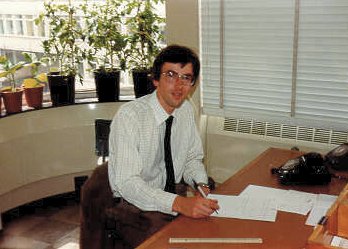 Me at my desk on Procter House
in 1978
|
Times have changed.
I used to have the above picture pinned to the wall above my desk. One day in the 1990s, a new recruit called Carolyn was studying it with some puzzlement. Eventually she asked me; "How did you ever do any work in the 1970s?". I asked her what she meant as it looked to me like I was working in the picture, but she said; "How could you do anything without a computer?" She was amazed when I explained that we used to write it all out in long hand.
It's also true to say that if you work in electronics, things go obsolete very fast. The things I worked on were new and cutting edge back then. Now they are mostly where they belong in the junk box of history. I even saw some of my stuff in the Science Museum.
My First Job at Silverhill Colliery
Silverhill was a coal mine near the village of Teversal in Nottinghamshire. Attached to it was the laboratory where scientific work was carried out. I worked in the Instruments Laboratory. We maintained the instruments from all the local mines. For the most part, these were methanometers which measure the amounts of methane in the mine atmosphere, but we also dealt with gas alarms, pumps, safety lamps, self rescuers and anything else that needed making or fixing.

A C4 Methanometer I have fixed thousands of these.
(Thanks to the National Coal Mining Museum for the picture)
Every Monday afternoon, George the van driver would arrive with boxes and boxes of things needing maintenance. Paul Elliott and myself would then set about fixing them all. Our boss was Dave Cooper who organised things and ordered all the spare parts. Dave was noted for whistling the same tune all the time and George was an expert in swearing. We once counted over 50 individual swear words during the delivery of a single box of methanometers. I have lost touch with all these people now, but if you see this guys, drop me an e-mail. Details on my home page.
Sorry, I have no photographs from my time at Silverhill. If you have any, please let me know. You can find some on the Silverhill Facebook page.
Silverhill Colliery is now closed and is now a country park and wood. It really is hard to imagine now all the buildings, winding gear and spoil heaps.
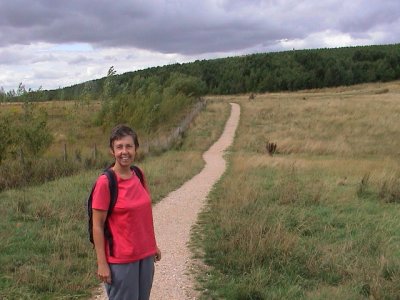 Where has the pit gone? What it looks like now. |
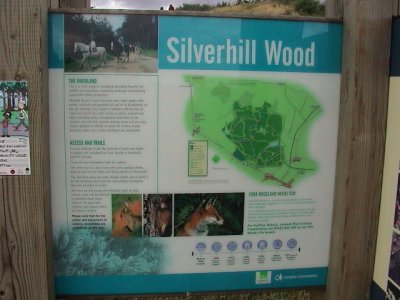 It's actually become a nature reserve. It looks a lot better. |
TXE4
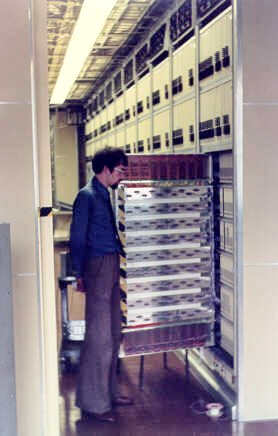 |
After studying for my degree at
Liverpool University, I joined Post Office
Telecommunications (now BT). My first job was in the
development department where we were working on a
new type of large telephone exchange (central
office) called TXE4. This was the early 1970s and up
until this time, most telephone calls were handled
by electro-mechanical exchanges based on the
Strowger system. Strowger exchanges were full of
moving parts and if they went wrong you had to clean
and oil them. TXE4 changed all this. It was an
electronic system controlled by a simple computer.
By modern standards, the technology was crude, but
this was the first use of electronics on this scale
in the UK phone system and it was a revolution. The old Strowger exchanges made a huge rattly noise, but when the TXE4 took over, a strange silence fell over the building with just the odd muffled whirr and click. Many people found this disconcerting and used to gather round the Main Control Units where the flashing lights at least offered a sort of reassurance that the computer was actually doing something. These days we are used to letting computers get on with things, but back then it seemed strangely futuristic. In their early days. TXE4 exchanges were not very reliable and I became part of the "Panic Squad" (unofficial title). We were sent to various parts of the country to sort out problems some of which were so serious that the whole town had lost its phone service. Gradually, these things were all sorted out. The picture on the left shows me standing in front of a cyclic store rack at Manchester Blackfriars exchange in 1979. Note the flares and beard. |
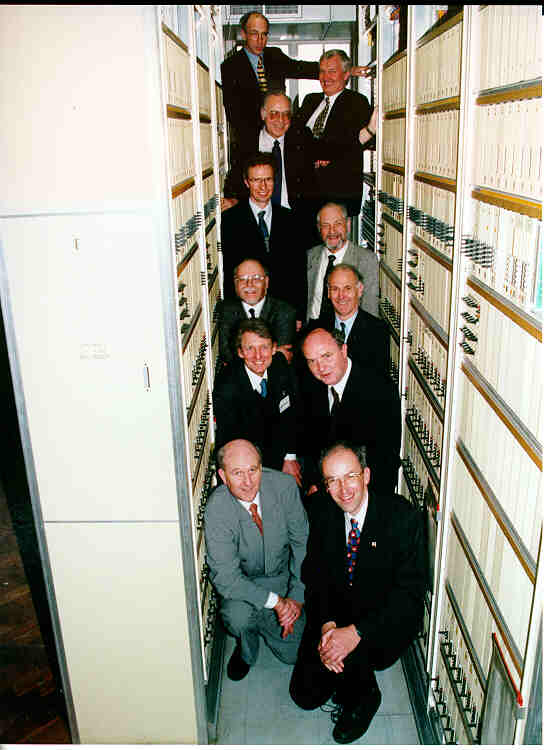 |
TXE4 was put together by a young team
and I was the youngest. We had a lot of fun. All
things come to an end and in 1998 was all gathered
together again in Leigh on Sea, to see the last TXE4
taken out of service. Twenty five years later, we
did not look so young. The picture below shows the
team surrounded by the last TXE4. I have still got a register card (RPS0331) somewhere in the loft which I was given as a souvenir of my time on TXE4 This is one of the official pictures taken at Leigh on Sea in March 1998. It shows (top down), Gerry Gaule, Adrian Jolly, John Watts, Andy Papaspyru, Bill Mayes, Quin Collier, John Goodman, Barry Trawford, Dennis Carpenter, Colin Jackson, Nigel Pope. |
Testing Testing
| When I left the TXE4 team for
pastures new, I spent a while doing testing work on
new signalling systems. This was at a time when
digital signalling was coming in and replacing older
ways. As you can see, the test equipment was large
and (to be honest) a bit of a lash up. Ultimately,
it was driven by a BBC B computer. It did, however,
work and automatically ran through the test script. The mobile phone in your pocket has more computing power now than all that lot put together. This picture is from 1986. This was an interesting time. BT was a newly privatized company and it was putting its engineering past behind it and starting to focus on what customers actually wanted. That's where I wanted to be too. Then promotion came my way and I got my chance to take charge of a new and exciting project which was looking to improve customer service. Some said it would never work, but it did........ |
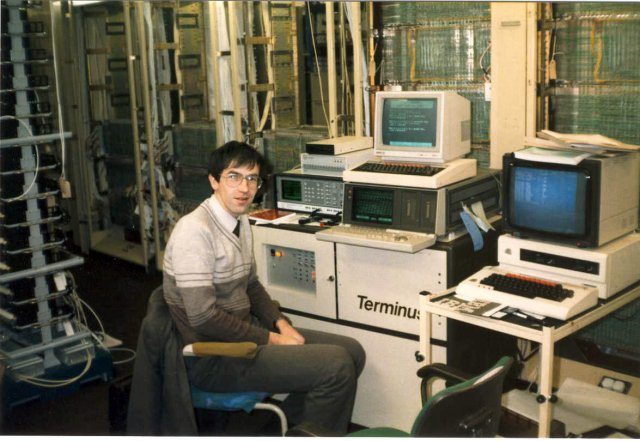 |
Payphones and Chargecards
| In 1986, I
joined Payphones. In those pre mobile phone days,
this was a big operation. I was in charge of
the Cashless Services Team. We looked after all
those payphones which took their payment by
electronic means rather than by traditional cash. At
first, this was done using a pre-paid card called
Phonecard (remember all those bits of green
plastic). Later, we started taking Credit Cards and,
in addition, we launched our own credit card called
BT Chargecard. These products were a major success
and we were selling millions of cards every year. Phonecard was a massive success and we sold so many that the factory could not keep up with demand so I was forced to withdraw the £1 card. The customers were not very happy about it but I had no choice. BT Chargecard was something quite new. You punched in the number on the card at any phone and this transferred the charges to your home phone bill. I remember so many people telling me it would never work but the customers loved it. We issued millions of them. The service tested the 1980s computer technology to the limit but it was surprisingly reliable. I had to deal with everything from engineering to marketing in this job and I realised that marketing was going to be the thing of the future and this would be my future career path. The people in Payphones were a great team and we still keep in touch. Below are a few pictures of the team in action: |
A phonecard. Always green
|
|
BT Chargecard. I was in charge
of the team which launched this product.
|
 Pete and Guy at the Last Team Meeting |
 Pete, Jane and Jo on the "Ethnic Food" trip |
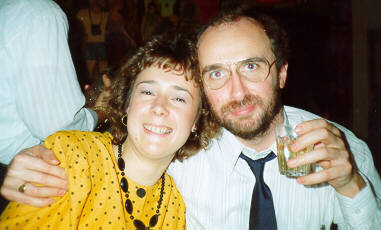 Tracy and Guy at Anemos |
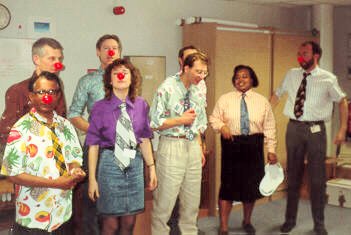 Comic Relief Day 1989 at Payphone House.It was "silly shirts". Sharma, Norman, Dave, Tracy, Nick, Roy, Jane and Guy |
Here is a video showing office life in December 1989.
International Agreements
In the late 80s and early 90s I was involved in various collaborations with companies in the USA and Japan as well as working on international standards for Chargecards. In these pre-internet days this involved a lot of international travel. I traveled to meetings all over the world and I have to say that this sounds like fun but it really isn't. Some of the stranger things that happened include:
- Flying to San Francisco for a meeting and then flying back the next day
- Eating dried raw octopus crisps in Tokyo
- Arriving in Ottawa in a light aircraft
- Trying to find something to do between standards meetings in grey winter Geneva
- Taking 3 years to get international agreement to a 3 page document
- Finishing work in San Diego on Friday evening then flying to Tokyo on Saturday morning, crossing the date line and arriving on Sunday evening. What weekend?
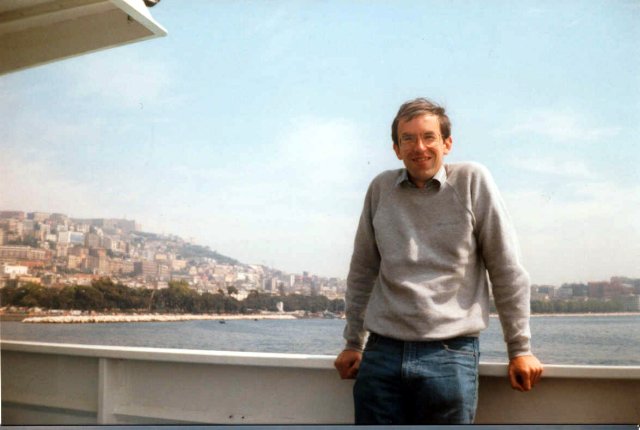
On the ferry from Naples to Ischia for a CEPT meeting
Telex, FeatureFax and Private Circuits
One day in 1995, I got the chance to move back into product management again. This time working on Telex and FeatureFax then later also on Private Circuits.
Now Telex is a very old product. It is a text message service where you type a message into a teleprinter at one end and it comes out of a teleprinter at the other end of the world. It was launched in the 1930s, and many people were surprised to hear that it was still going. In fact, it was still very much alive and making a lot of money but because of its obsolete nature it lacked any real effort being put into it. Oddly it had been put into a department which managed a raft of new data products plus this one old one. I decided to get it growing again and soon the little Telex team was winning all sorts of awards.
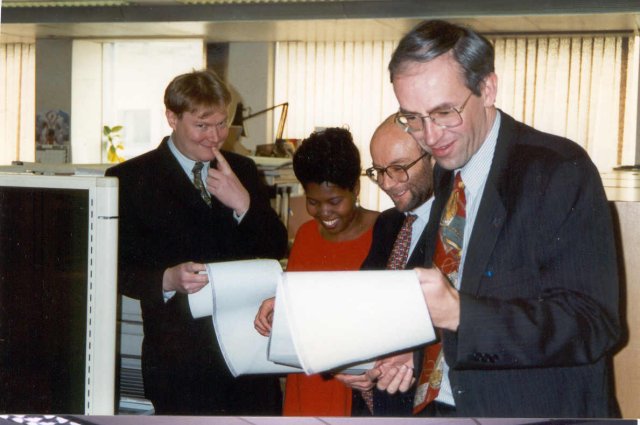
Tim, Pearl, Tony and Me looking at a lengthy Telex message
Once again, I was fortunate to work in a department with a great team. Here are a couple of pictures:
 Typical office scene |
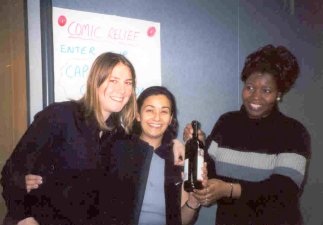 Carolyn, Hardeep and Pearl |
KVSA
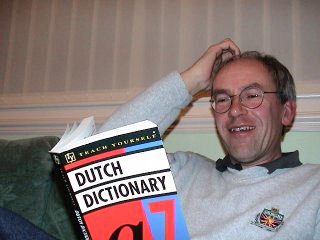 |
After I retired, I did a bit of
consultancy work for a Dutch company, KVSA (Royal
United Ship Agencies). This was interesting work and
lots of fun. It was mostly marketing stuff, partly telecommunications and partly shipping (which I don't know much about). The misunderstandings have all been part of the fun and I can tell you that the team at KVSA are a great bunch of people to work with. If you have never been to Amsterdam, I can strongly recommend it. I don't do it any more. I am fully retired now. |
Random Pictures
I have got hundreds of photographs taken at work over many years. Here are a few of them which don't really fit into the story above:
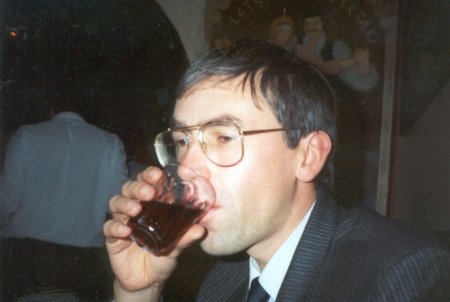 Trying out the wine at Anemos |
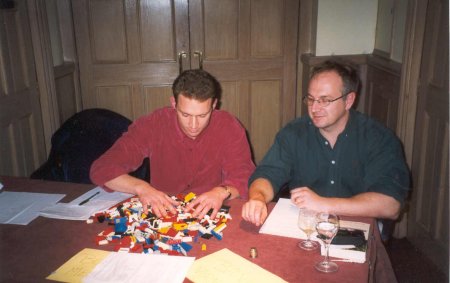 Some jobs are harder than others. Rupert and John team building. |
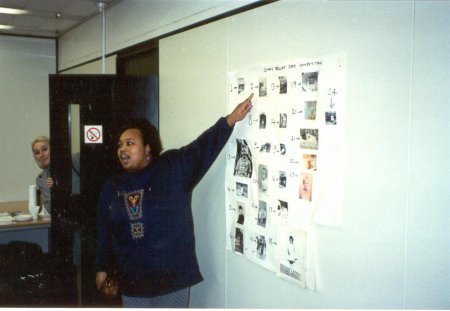 Jane and a quiz at New Garden House |
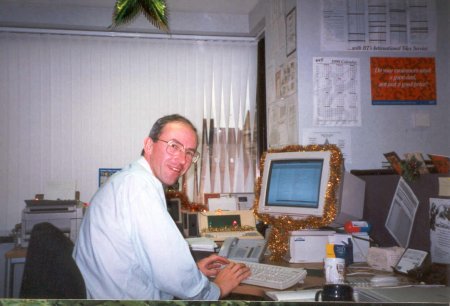 At my desk in Holborn Centre 1999 |
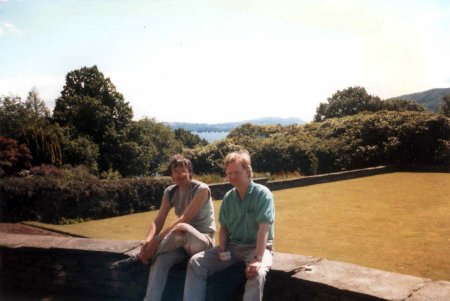 On a High Impact training course in the Lake District |
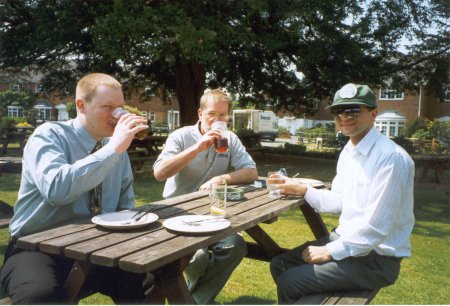 Tim, Rhys and Tony prepare to cycle the New Forest |
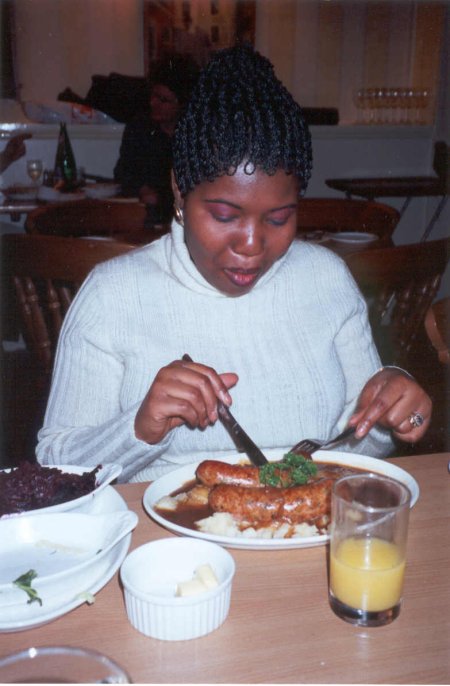 |
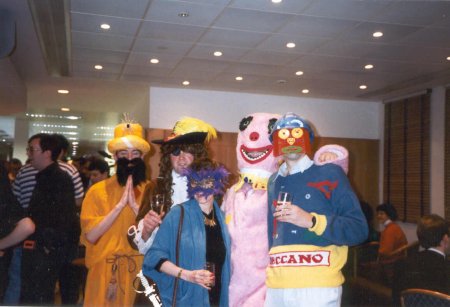 Above - Me as Meccano Man at some
fancy dress event. John is the pirate and Annabel
is in the blue mask. I never did find out who was
in the Mr Blobby suit.
Left - Pearl with her fantastic hair. Those sausages were a lot bigger than she expected. |
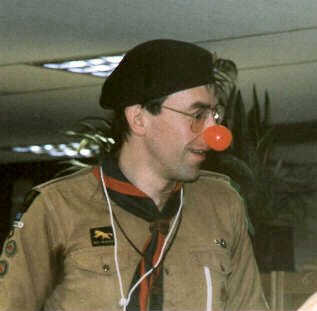 |
The pictures I have shown so far might suggest that I have not always taken work all that seriously. As you can see from the photograph on the left, I have always tried my hardest, and I am happy to report that this costume won first prize in the Office silly shirts contest in 1989. What further proof could you want? |